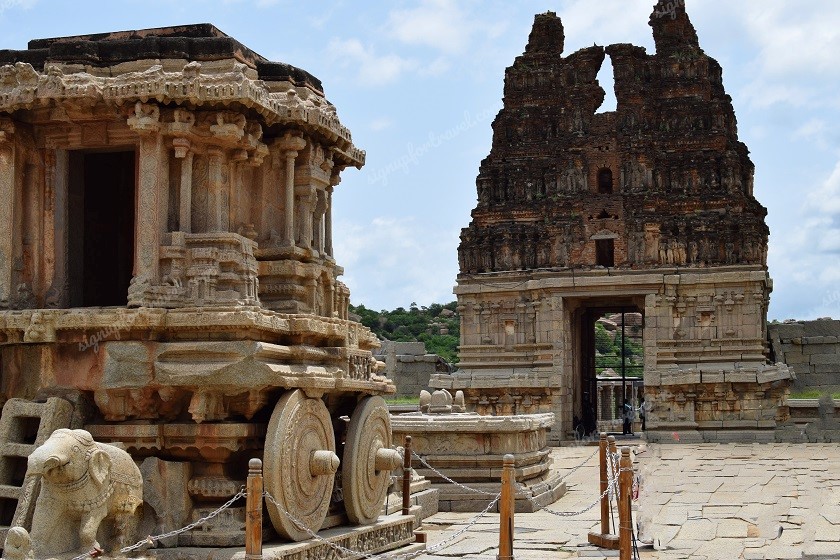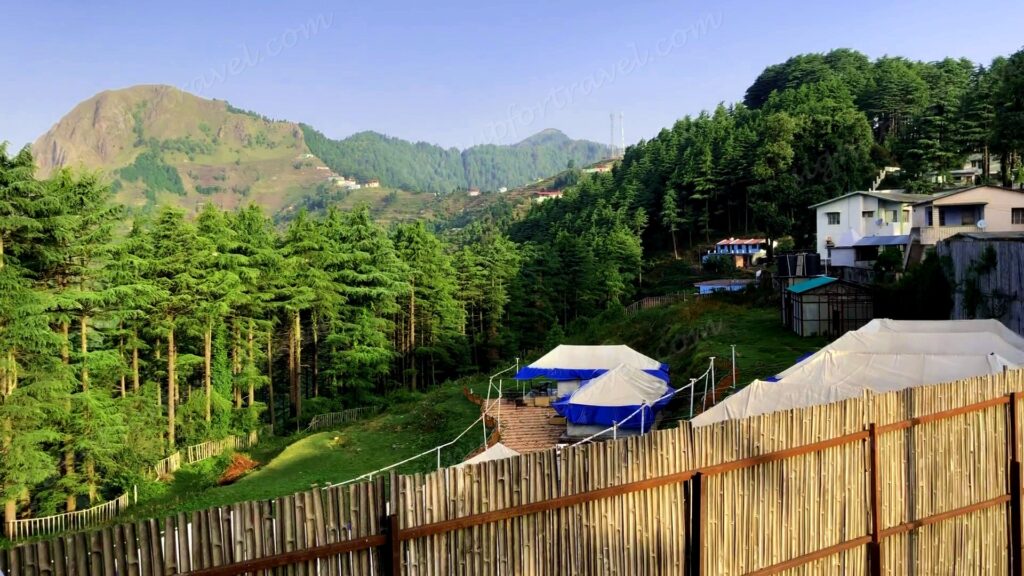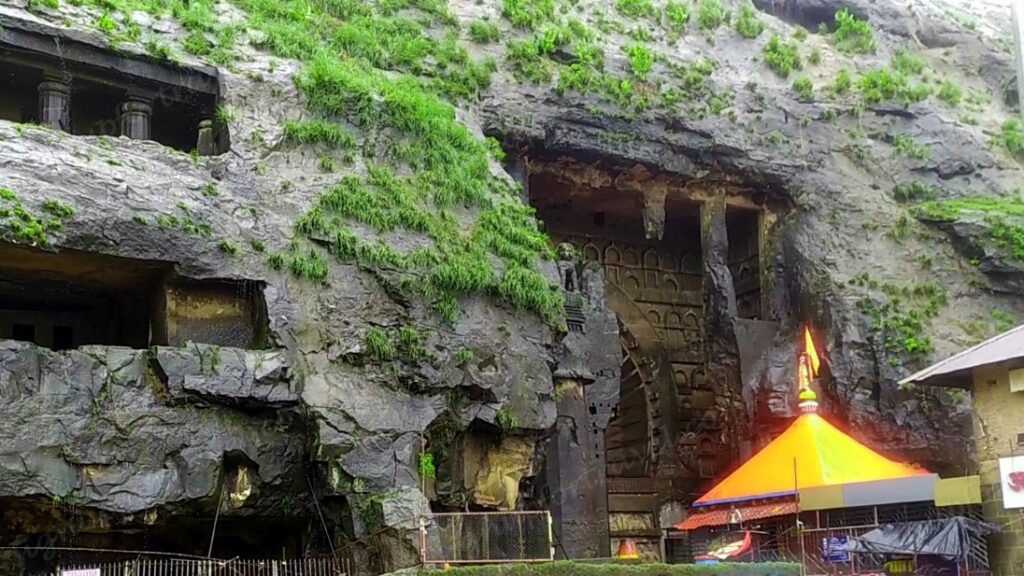Table of Contents
- A relaxed start
- The plan
- The start
- En Route to Vitthala temple
- Few important things to know
- Places before entering the temple
- Vitthala temple
- Beyond Vitthala temple
- The lunch fiasco
- Exploring Hampi Take 2
- Sasive Kalu Ganesha
- Lakshmi Narasimha temple
- Badavalinga temple
- Krishna temple
- Hemakuta hills
- Virupaksha temple
- Closing Day 2
- Link to Day2 YouTube video
1. A relaxed start
This is the day 2 of our chasing history series chronicling our journey to north Karnataka. On day 1, we reached Hampi from Pune and today we begin exploring Hampi.
Believe us, it is not at all easy to ride a motorcycle for more than 550 km and that too with a pillion. Our butts were sore, our legs had cramps, and our bodies were broken but then the spirits were not. After a decent night’s sleep, we woke up relatively fresh at around 8 AM, went about our routine and were ready for breakfast by 9 AM.
We then headed to the rooftop restaurant for breakfast and boy what a sight it was. Banana plantation, then the river, the boulders and to top it up clouds on the horizon, it was a beautiful sight.

We had idli, sambar and chutney for breakfast. It was good as expected.
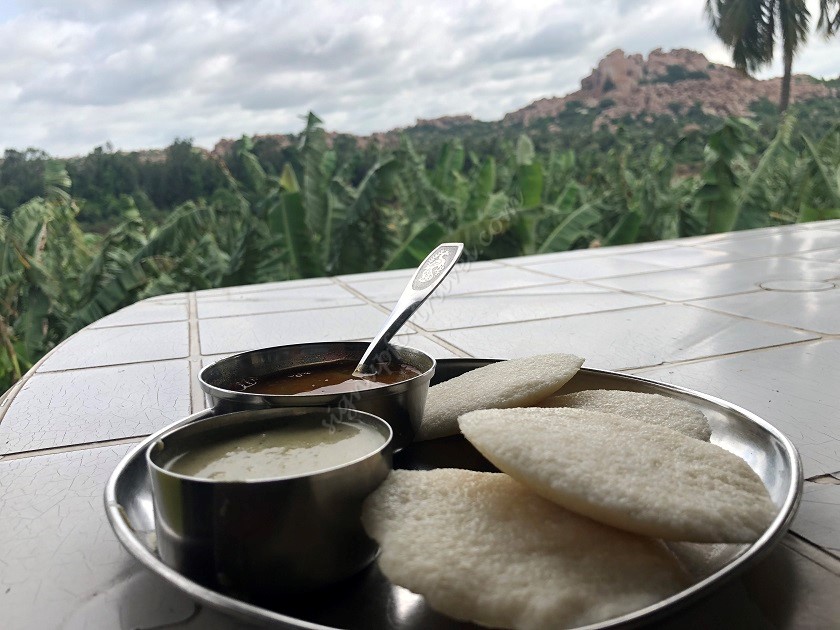
We finished our breakfast by about 9.45 and were ready to start our exploration. It was bright and sunny though not very hot, the gust of winds also helped.
Several autorickshaws were available right where our guest house was to cater to people without personal vehicles. One can hire these autos for a whole day and they would take you around to all the places of interest. Typically, they charge anywhere around Rs.800, which could be up or down depending on the time of year. Bicycles are also available on rent starting 100/- per day from many guest houses provided you are willing to sweat it out.
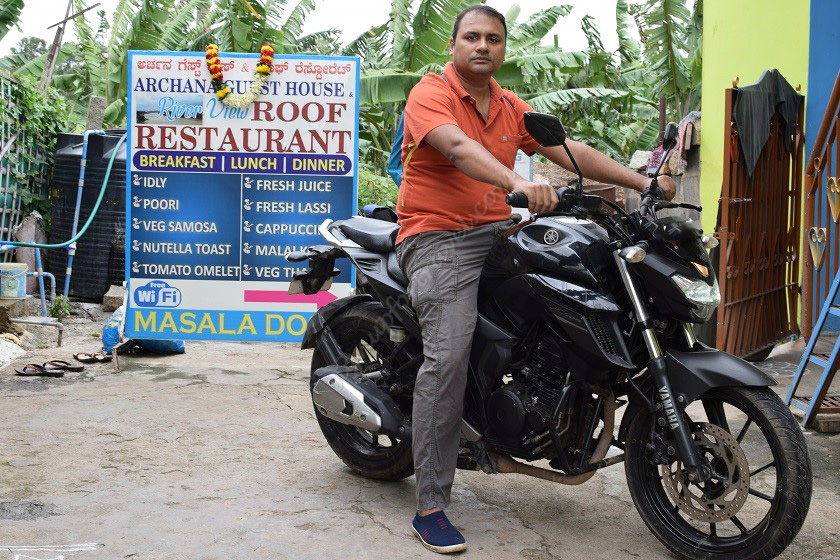
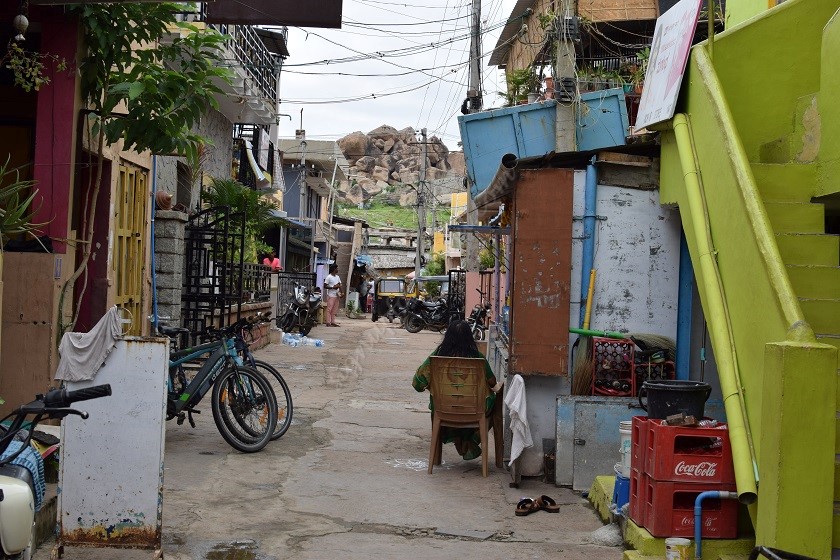
The time was 10 AM when we finally rolled out of our guest house.
2. The plan
We spoke extensively with the guest house owner to devise an optimum plan for the day. We only had a couple of days at our disposal and a lot of places to cover.
The plan was to first head to Vitthala temple (or Vijaya Vittala temple) which was the farthest from our guest house and then trace back covering other places on the way. The first stop before anything was to be the majestic Virupaksha temple which was the closest to our guest house.
3. The start
Getting out to the main road was itself a task as the by-lanes were very narrow and uneven, riddled with potholes filled with rainwater. We trudged out and were in front of the Virupaksha temple. This is one of the few temples left in Hampi which is not damaged and where puja happens to date. As this was Monday and a special day for the god Shiva, there was a crowd heading into the temple. We decided to pay our respects from outside and visit the temple properly later in the day.
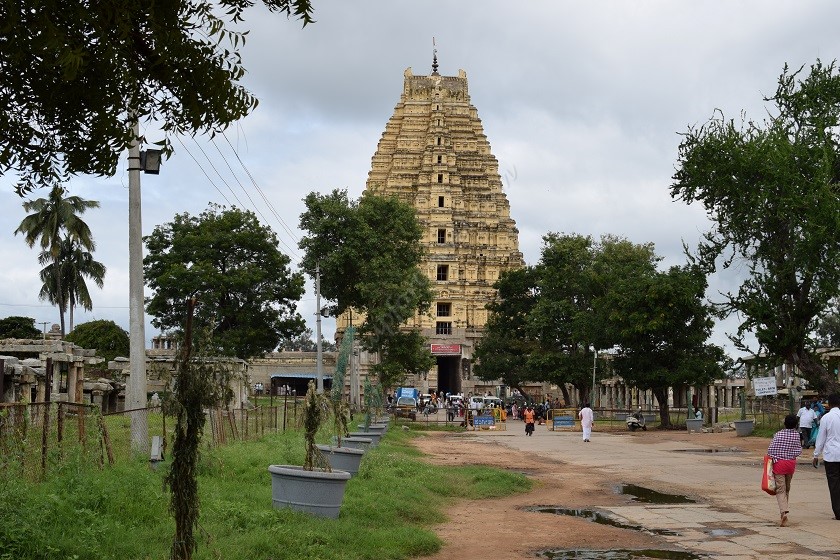
There were structures at the side of the road which seemed like a bazaar from the heydays.
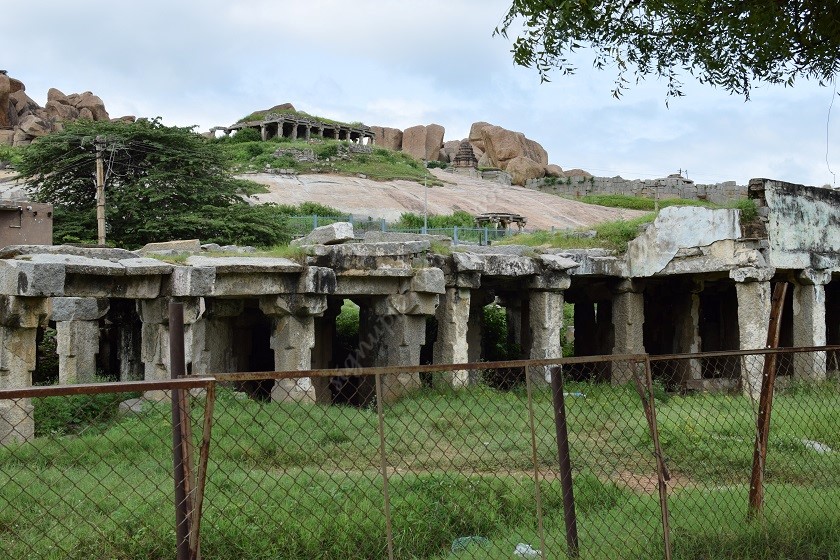
After clicking some pictures of the scenes around, we moved ahead towards Vitthala temple. As we moved out of the city, it was fascinating to view the ruins of what would have been a bustling city at its prime.
4. En route to Vitthala temple (scam before that)
After exiting the city, we reached a place called Kamalapura where we had to take a left to go towards Vitthala temple. This place was roughly 6 km from our guest house. Our bike was running low on fuel so we decided to fill it up. The attendant at the petrol station almost scammed us but we were alert enough to avoid it. Later on, we read reviews on google about this petrol station, we got to know that many people had been scammed. So, if you are filling up fuel at this station, make sure you are not distracted and scammed by the attendants.
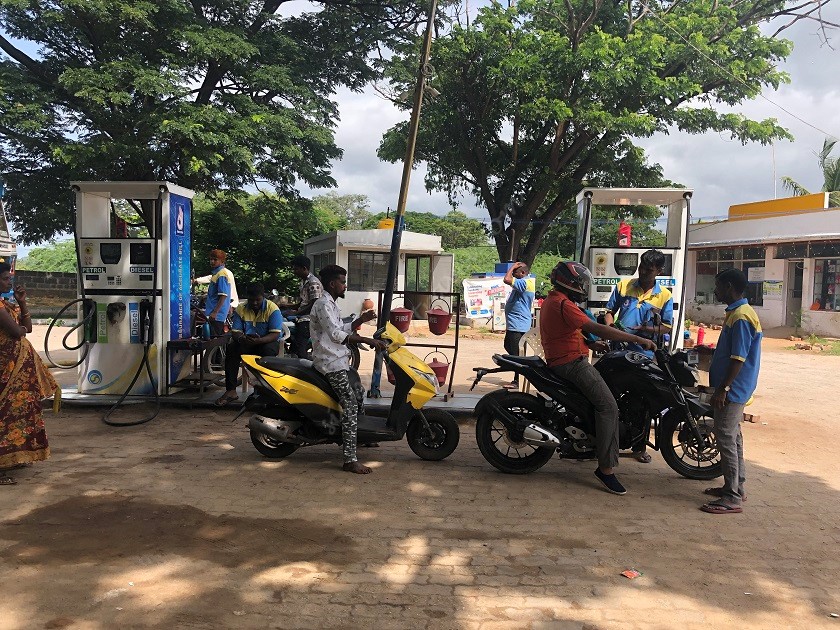
Thanking our stars, we proceeded ahead and reached a Y junction where the road to the left heads to the temple. The road to the right leads to Anegundi and Anjanadri hills (more on that later).
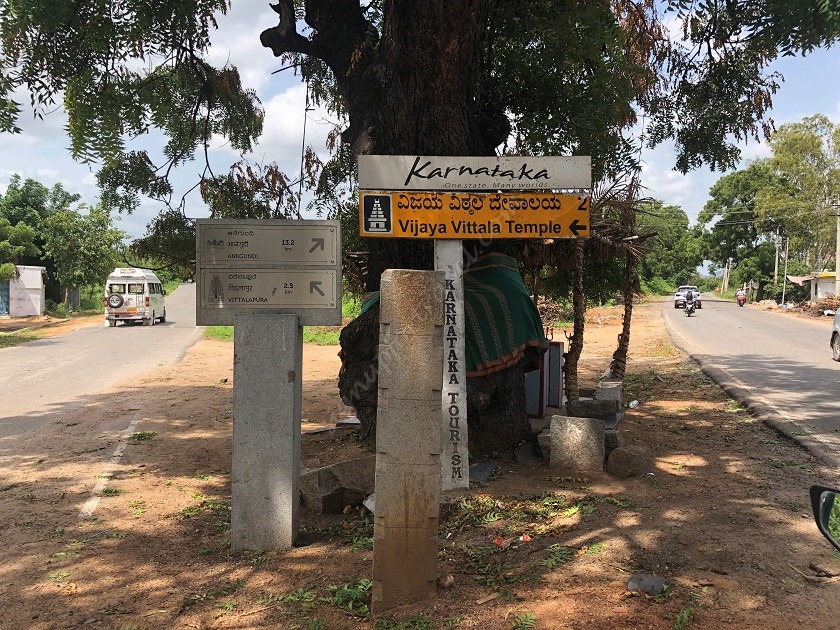
As we moved further, we saw beautiful fields with hills dotted with boulders.
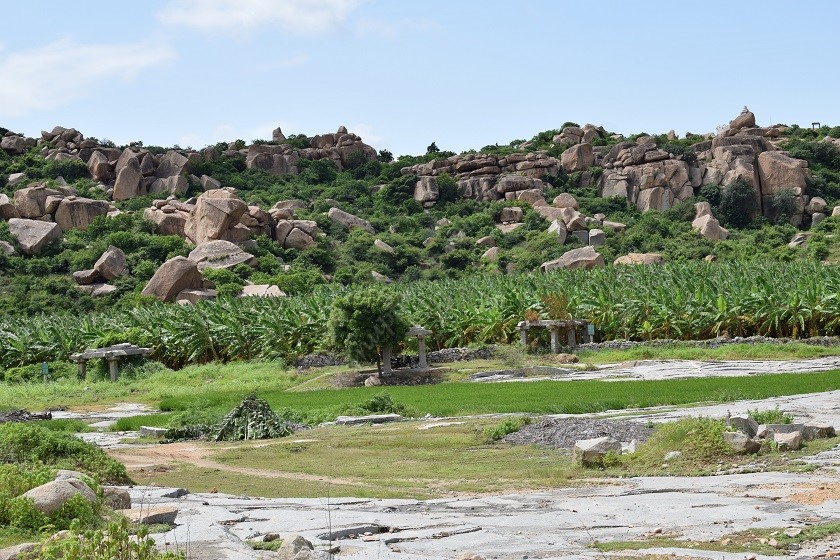
We then crossed a gate named Talarighatta (or Talavaraghatta) gate. From this place, ferry services are known to be available to Anegundi, though we didn’t explore this. This is a two-storied narrow gate with shrines on either side. One can call this a gateway to Vitthalpura which is the home to the famous temple.
5. Few important things to know
We moved ahead a few metres and saw the first sign of the temple.
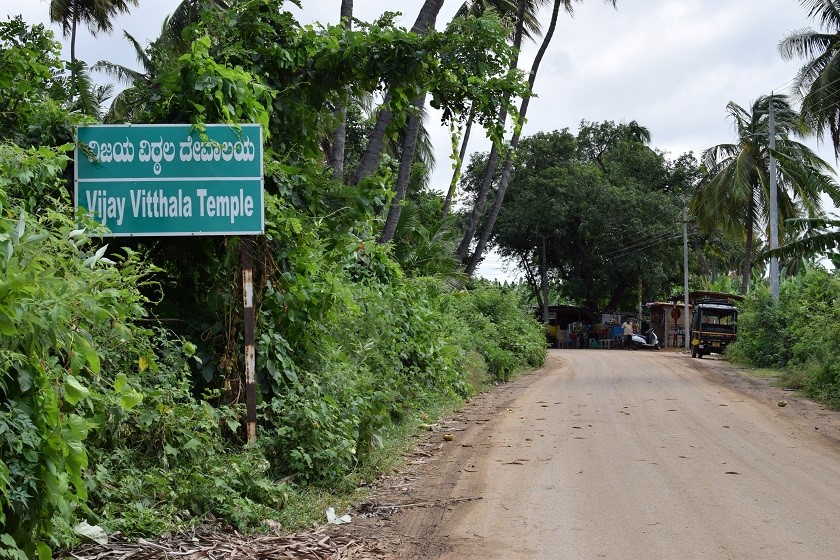
As one enters the area, there are several small shops selling snacks and other souvenirs. There is a dedicated parking lot ahead of this area. This parking lot is about a kilometre away from the temple. You can cover this either on foot or by battery-operated vehicles which charge Rs.10 per person on one side.
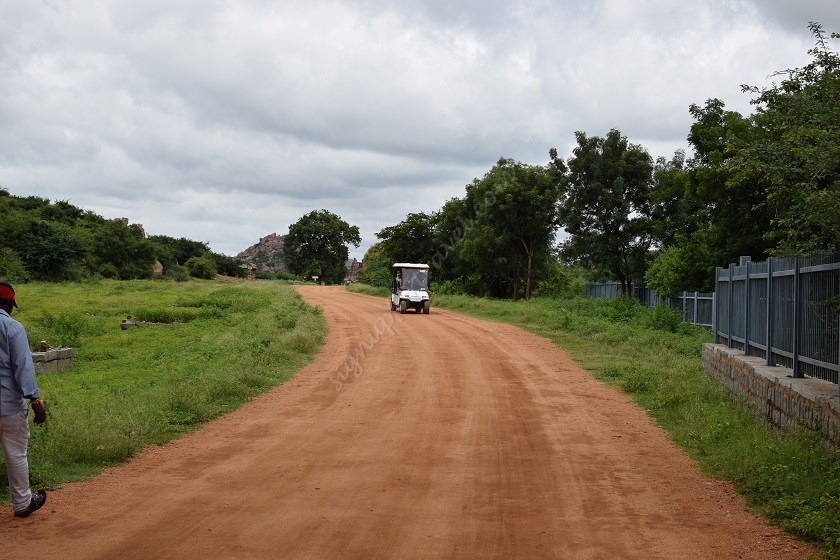
Earlier, personal vehicles used to reach the entrance of the temple, but the vibration and pollution caused by them began to cause problems in the structure, so the authorities banned them from the vicinity (a wise move indeed!). We decided to cover this distance on foot.
Guides are also available in the parking lot and one can hire their services for Rs.200 and upwards depending on the duration and details one is looking at. We duly hired a guide as we did not want to miss any details on this majestic place.
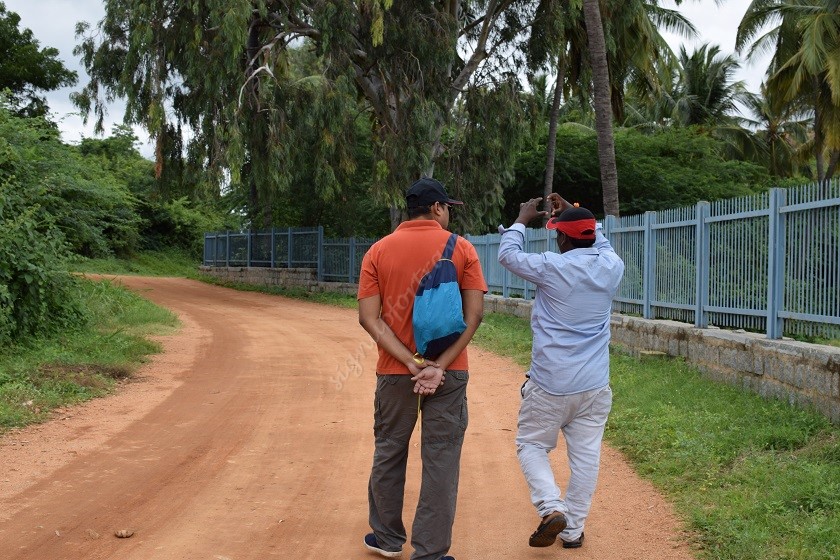
6. Places before entering the main temple complex
As we started walking towards the temple, there are several small structures and places which are worth mentioning.
Gejjala Mandapa- This is the first structure when you start walking towards the temple. It is an open mandapa and was used as an utsava mandapa for alighting processional deities.
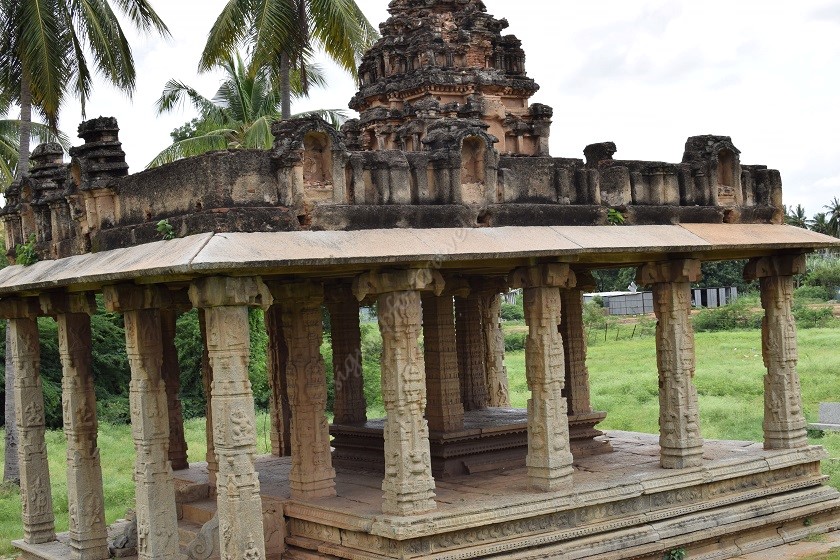
Kuduregombe Mandapa: Next comes the mandapa with a garbha griha, antarala and an open mandapa with pillars of horse riders at front. The name kudure means horse and thus the name.
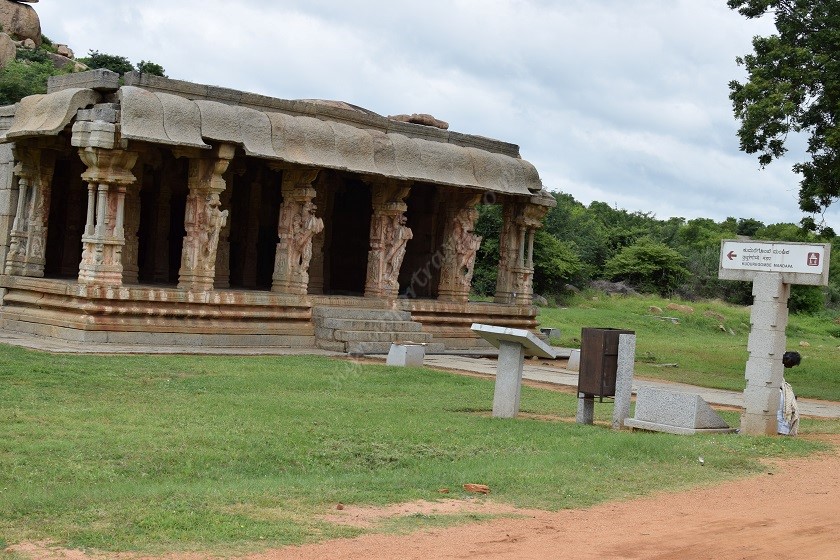
Pushkarani / Loka Pavani: As we moved towards the main temple complex, there was a sacred lake. This lake was previously dry but has now been restored by the ASI.
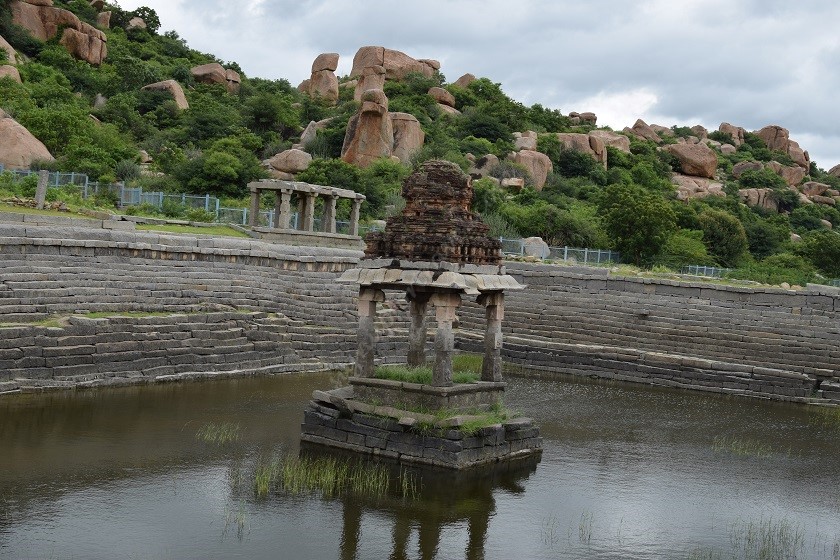
Vitthala Bazaar: Just ahead towards the entrance, both sides of the walkway are flanked by the market or the bazaar. The bazaar is 945 meters in length and 396 metres in width. According to the stories, horses were traded in these bazaars and traders from far-off countries used to visit.
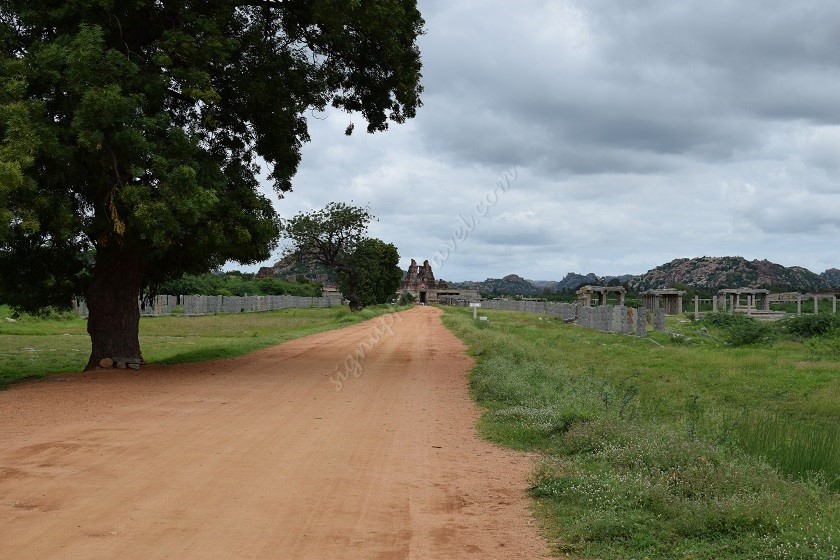
7. Vitthala temple (or The Vijaya Vittala temple)
After crossing all these, we finally reached the entrance of the main temple complex. The entrance fee per person is Rs.40 and this ticket is valid not only for the temple but also for the Hampi museum and the Lotus Mahal complex provided the visit happens on the same day.
The first visible thing is the damaged gopuram of the temple.
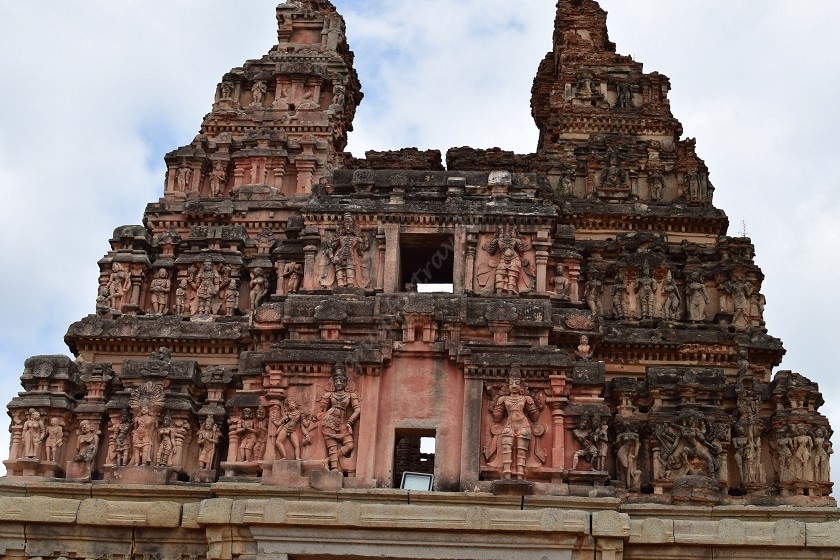
Inside the temple, there are various mandapas for different occasions with a stone chariot in the courtyard. There are three entrances to the temple: north, south and east. The main temple is dedicated to Vishnu as Vitthala which is east facing.
As soon as we enter the temple complex, on the right side, there is a mandapa known as utsava mandapa which was used for festivals and also the royal family used it as a prayer hall. On the left side was the Kalyana mandapa which was used to perform marriages of deities. On the front of the main sanctum are two huge mandapas known as Sangeeta mandapa (musical) and nritya mandapa (dance) mainly dedicated to the two queens of king Krishnadevaraya. Beyond that is the main sanctum of the temple. The main idol is a replica of the one found in the Vitthal temple at Pandharpur in Maharashtra. The chariot in front is the shrine for Garuda, the vahana of Vishnu. The chariot is a replica model of the ratha found in Konark.
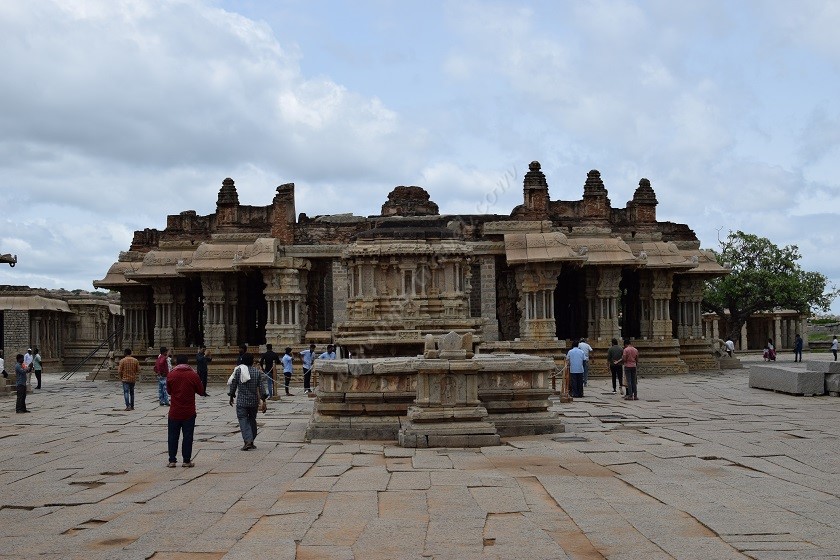
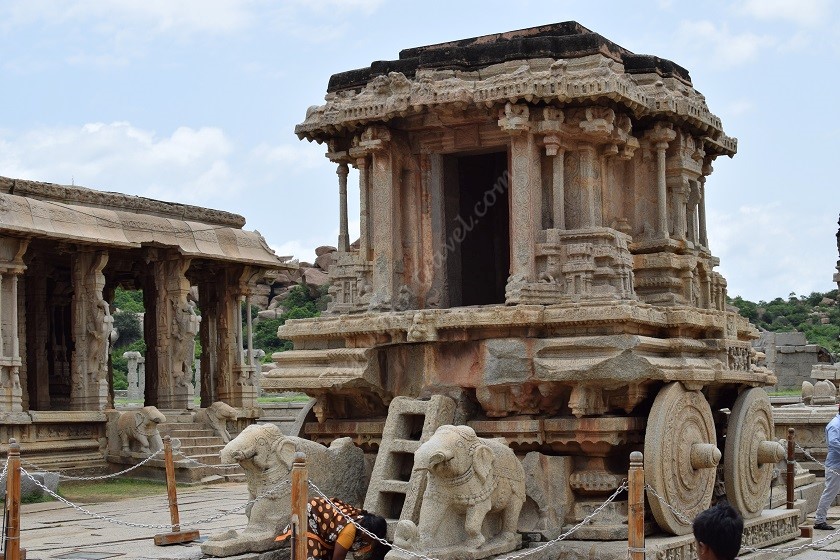
After spending around 1.5hrs in the temple complex listening to the stories from glorious times, it was time to move on.
8. Beyond Vitthala temple
There is an unpaved path towards the left of the main gate which leads to a few other monuments.
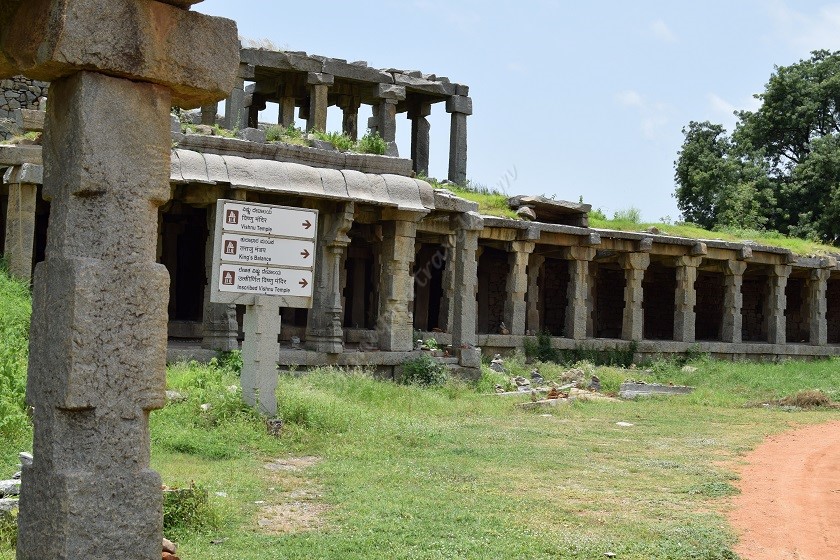
There is also the point to board battery-operated vehicles. This path leads to the Virupaksha temple, so if you can walk then, you can directly traverse between both these places.
The first point on this path leads to the King’s balance. This structure was meant for weighing the king against precious gems on important occasions like birthdays etc. and was gifted to the temple or the people.
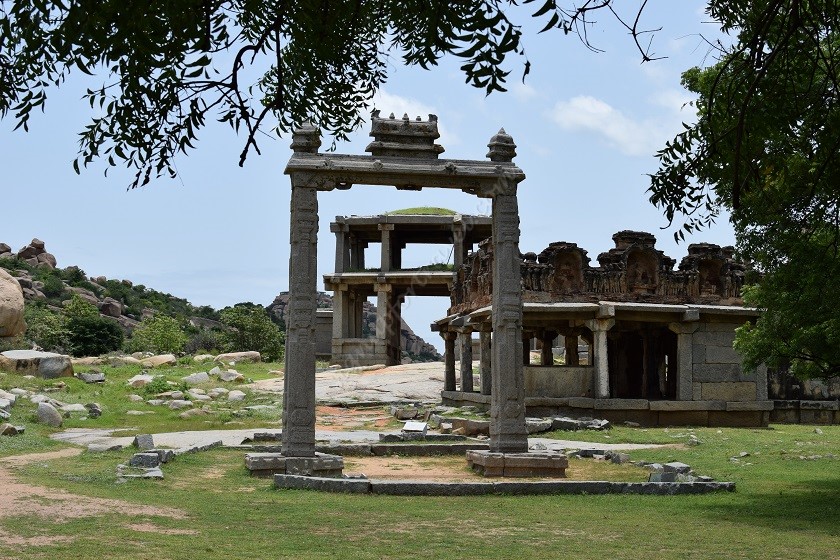
Once we crossed the king’s balance, we came across a mandapa submerged in water known as the Purandara Mandapa. This is named after the saint and famous composer of Carnatic music – Purandaradasa.
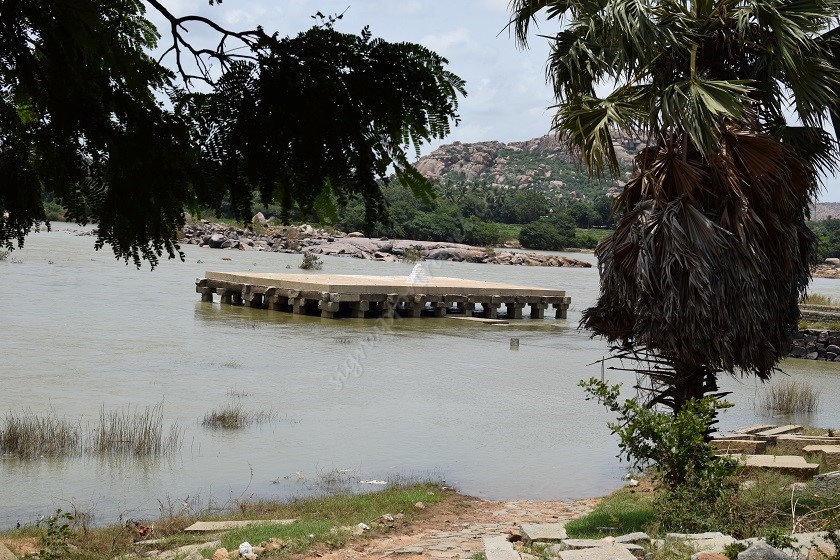
A stone bridge was also slightly visible which was used to cross the river in earlier times.
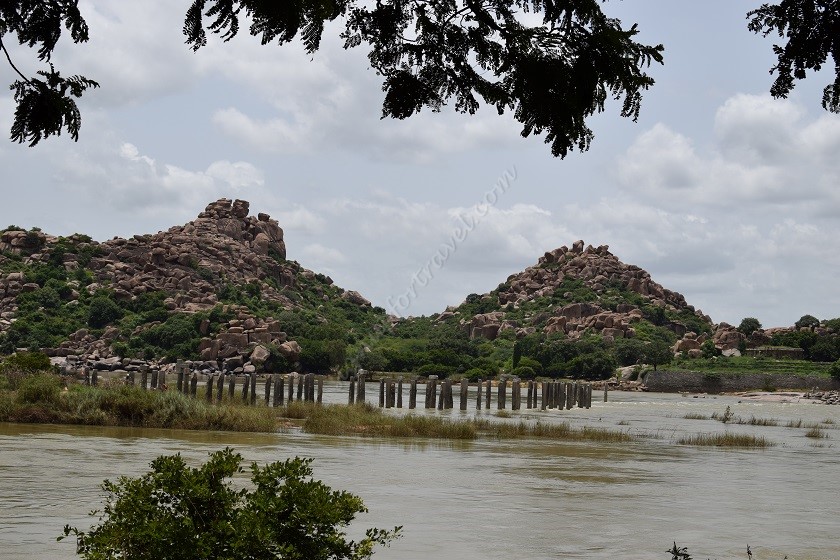
It was just past noon and was extremely warm and uncomfortable. A small shack selling buttermilk near this location came to our rescue. It was a much-needed break.
There was a sacred banyan tree in between which we think was a kind of wishing tree as there were many things tied to it.
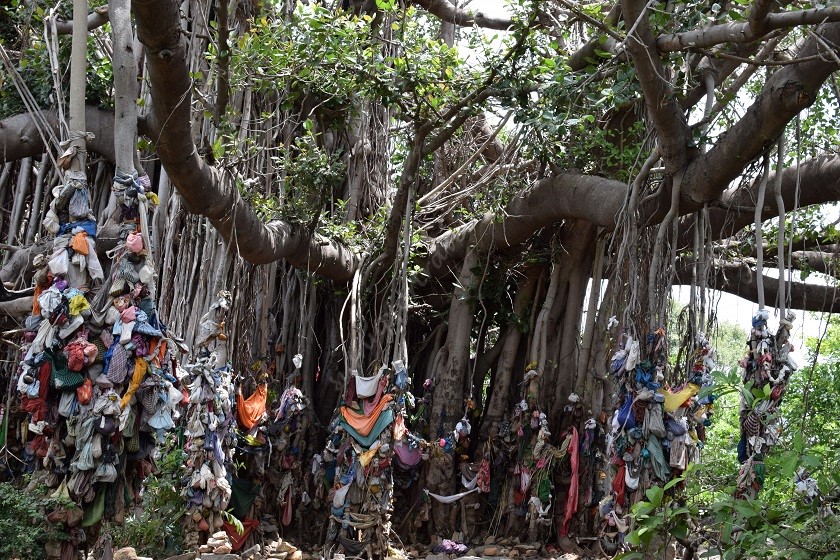
There was a pond as well ahead of the tree named Sita Sarovar.
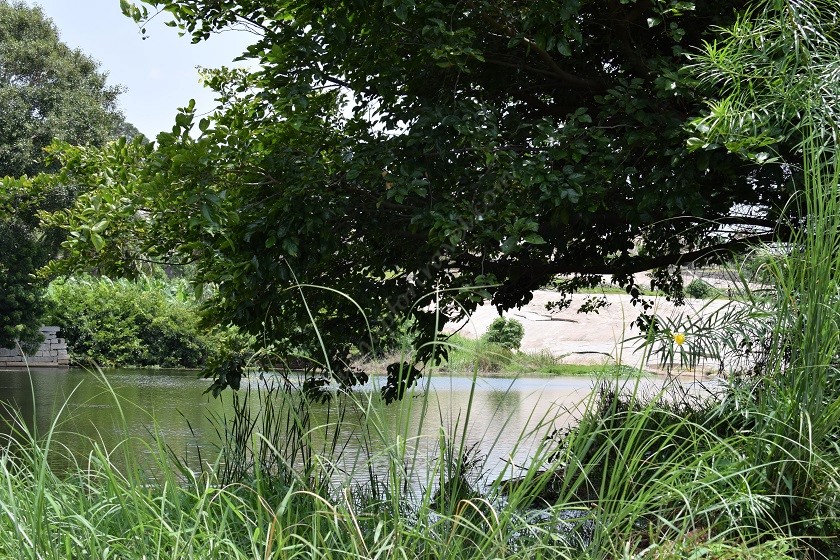
Although we could have carried on to other places ahead, we decided to retrace our steps. We came back to the parking area at around 1.30 PM.
9. The lunch fiasco
We came back to the Kamalapura junction and started searching for a restaurant to have lunch. The heat and hunger got the better of us and we headed to a restaurant which was in front of us “Sai Family Restaurant”. The time was 2.10 PM.
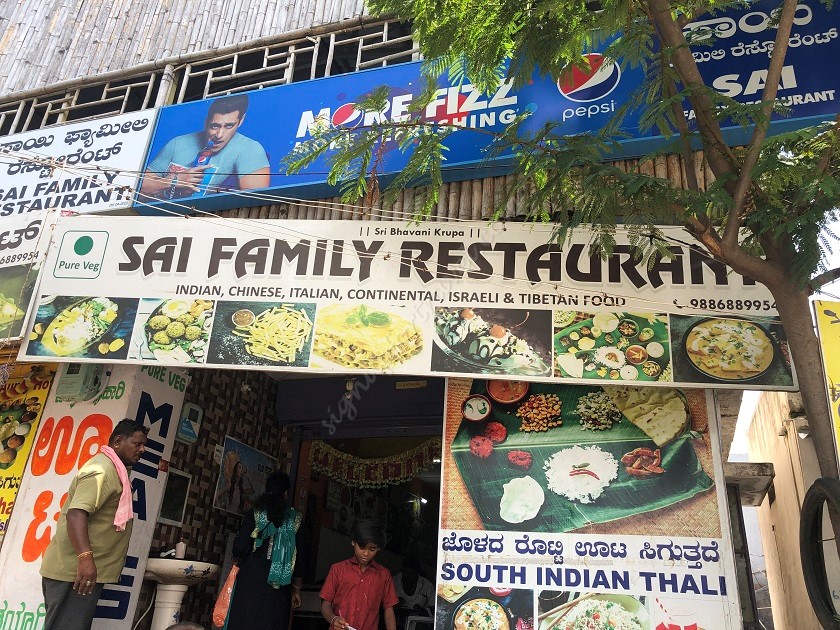
It seemed like a place which was frequented by locals and was overcrowded. After waiting for 10 minutes, we managed to find a seat. We ordered a plate of veg kolhapuri, rice and roti. The waiting time of around 15 minutes which sounded reasonable. After the wait time, we finally got a glimpse of our order. But the joy was short-lived as the dish ended on one of our trousers. The person bringing the order was in such a rush that they tripped, and the dish landed on one of our dresses. Instead of feeling sorry for the mistake, we could hear some smirks and giggles around. It required a visit to the washroom to get rid of the top layer of the dish (by that time the oil had gone deep inside). Anyway, our appetite was ruined, and we finished our lunch.
Now, there were two problems, one was the searing heat and the second was the ruined dress. We decided to head back to the guest house to change and also to take some rest.
10. Exploring Hampi – Take 2
We took a much-needed break at the guest house and recharged ourselves. Now we had to re-plan how to best utilize the rest of the day. We came up with a plan to explore the nearby places on foot.
We started again at around 4.30 PM.
11. Sasive Kalu Ganesha
The monument is housed in a mandapa and is a huge monolithic sculpture of Ganesha. The name Sasive Kalu in Kannada means mustard seed which depicts the round sculpture. This statue is around 2.5m tall. Legend has it that Ganesha had too much to eat that his stomach almost burst for which he tied a snake around which you can see in the sculpture.
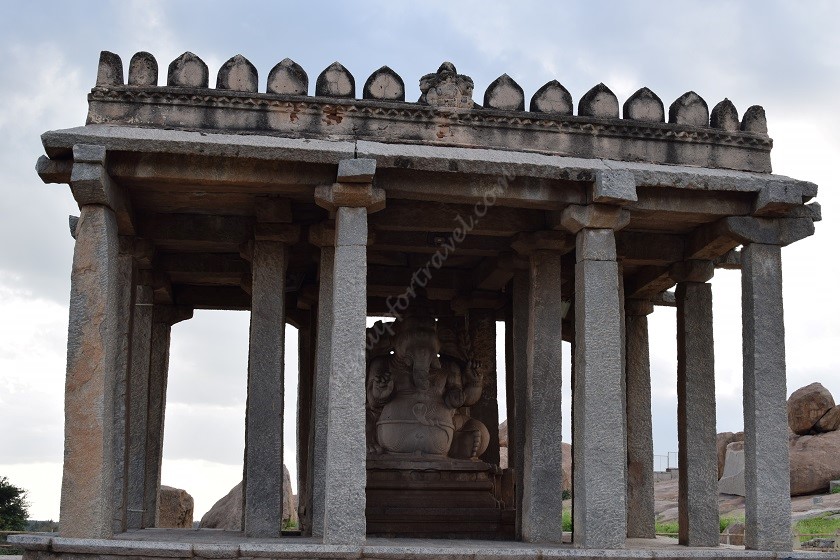
Our next stop was the temples of Lakshmi Narasimha and Badavalinga, we asked around and chatted with a few locals who advised us to take a shortcut. This shortcut was through a beautiful field. As we moved ahead, the skies seemed to open up and we could feel a few drops. But gosh we didn’t bother to carry our rain gear. With the hope that the rain does not get too heavy, we reached the shrines.
12. Lakshmi Narasimha temple
The shrine is huge at 6.7 m and was outstanding to look at. The statue sits on the coils of sesha with the image of Lakshmi seated over the left lap of the deity (this is now mutilated). Only the left arm of Lakshmi is visible. There is a seven-headed serpent over the head of the deity. The overall structure is in a bad condition which made us sad.
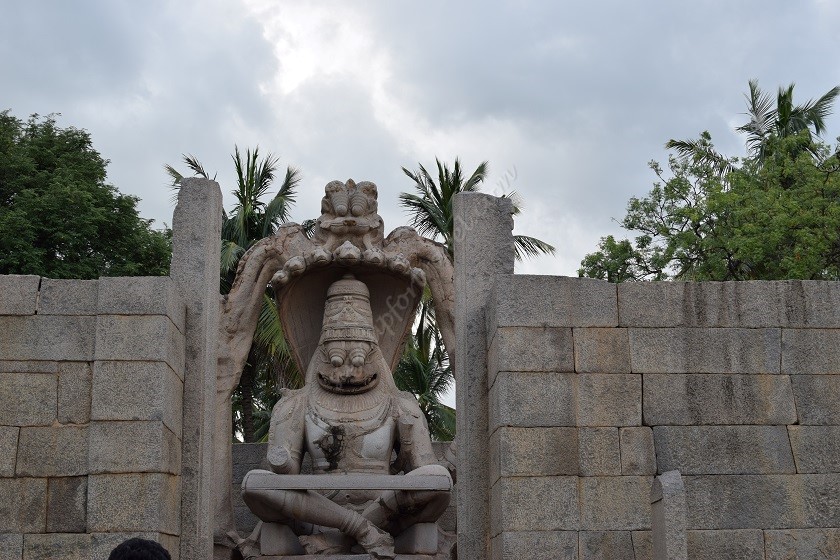
13. Badavalinga temple
Very next to the shrine of Lakshmi Narasimha is a huge monolithic shiva linga which is nearly 3m high. The lower part of the linga remains in water throughout the year. The water comes from a canal drawn from the Tungabhadra River. The light falls on the linga from an opening on the roof which makes it look divine.
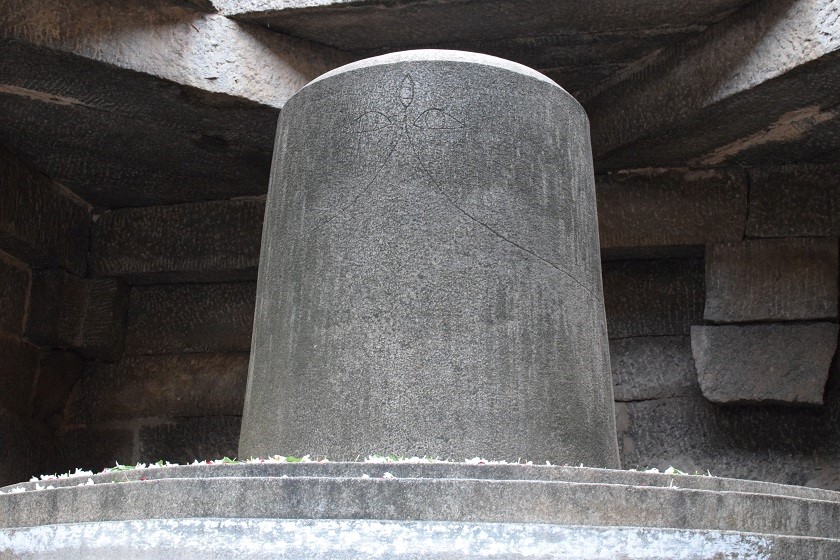
14. Krishna temple
The slight drizzle stopped, and we walked down the road to our next stop, the Krishna temple. By the time we entered, it had gone quite dark. Remember that the monsoon was still on, and we finally managed to experience it.
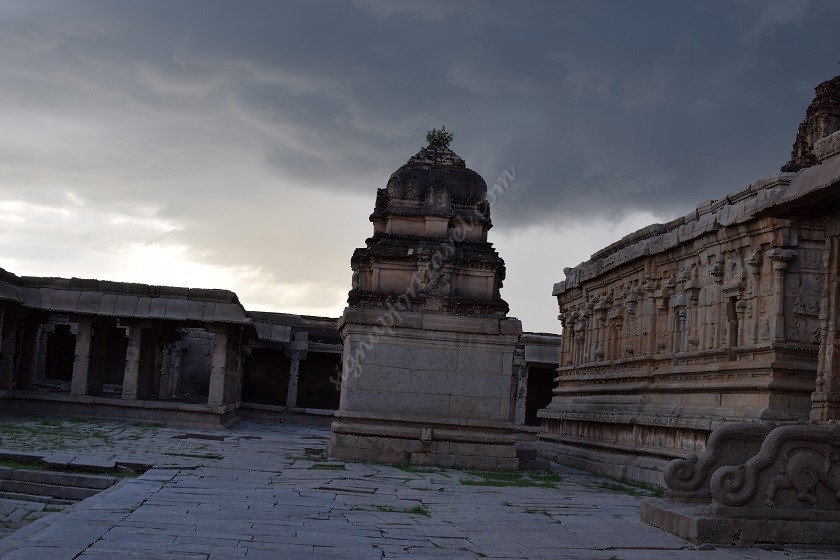
As per the inscriptions, an image of Balakrishna was brought from a temple in Odisha and enshrined in a mandapa here. A bazaar and a pushkarani (sacred water tank) accompany this shrine.
The rain gods finally decided to bless us with a shower and it started raining heavily. We took refuge inside the main temple mandapa. It must have rained for around 30 minutes and we sat around enjoying every moment. We had read about Hampi coming alive during rains and we were witness to it.
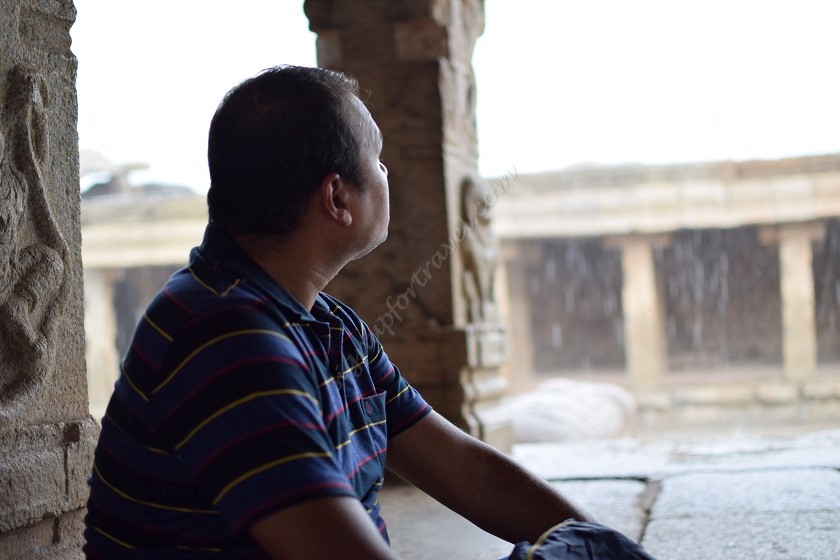
The rain stopped after a while and we walked out to fresh and lush green surroundings. We walked for a few metres towards the Hemakuta hills to witness the sunset. According to locals, the best point for sunrise is from Matanga hills and for sunset, it is Hemakuta hills.
15. Hemakuta hills
We read various blogs about how the hills become slippery and dangerous after rains. We were now in the middle of it. The Hemakuta hills were not very steep, it was just a gradual climb yet the bouldery surface had become extremely slippery. We were sliding like crazy and holding each other until we managed to reach the top.
The Hemakuta hill is believed to have around 30 temples of varying sizes and shapes built between the 9th to 16th century AD.
The view from the top is breathtaking and shows an eagle-eye view of the city. The sunset was also worth the hype.
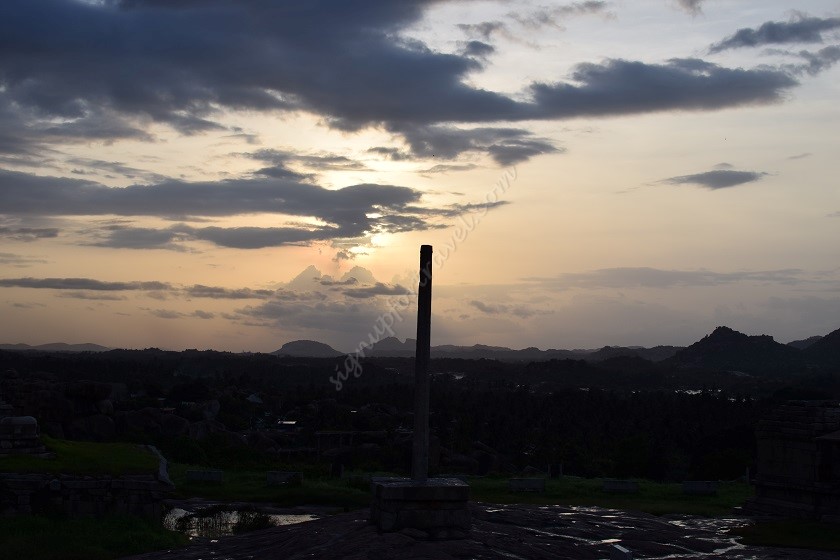
There is a pathway to the north of the hills which leads directly to the Virupaksha temple. We kept sliding and slipping and after quite some effort reached the temple.
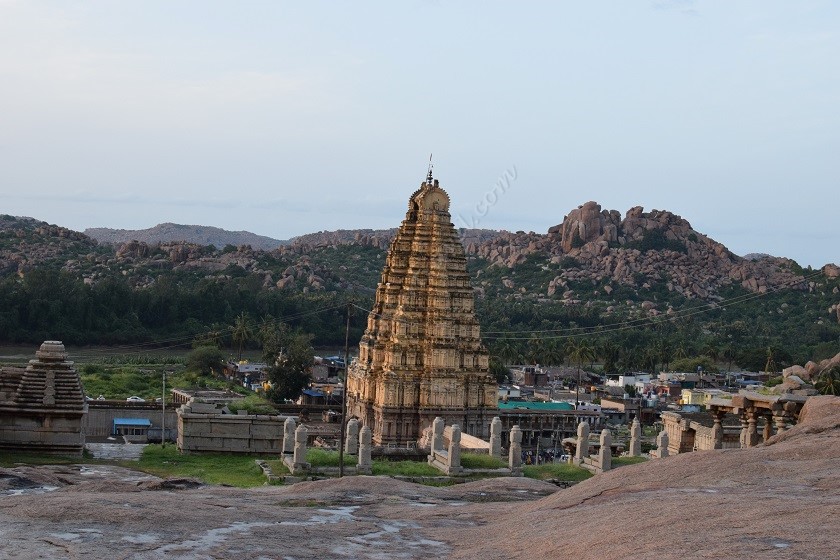
16. Virupaksha temple
The highlight of the town and one of the live temples, we were finally at the entrance at around 7 PM. We quickly gave our footwear to the people managing the stand and entered the temple. Due to rain, the surface was wet and quite a few puddles formed inside. It was very soothing walking barefoot over these puddles.
As mentioned at the beginning, since it was Monday quite a few activities were happening inside. The complex has numerous subsidiary shrines, some of which include Mukti Narasimha, Pataleswara, Navadurga, and Parvati among others. The main sanctum houses Shivalinga is known as Virupakshha, the main deity of Vijayanagara kings. When we reached the temple there was a group performing bhajans as well.
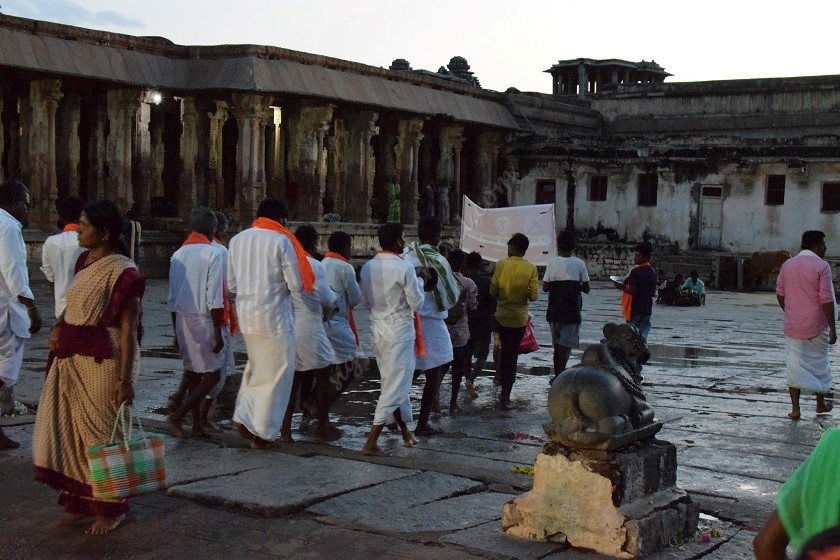
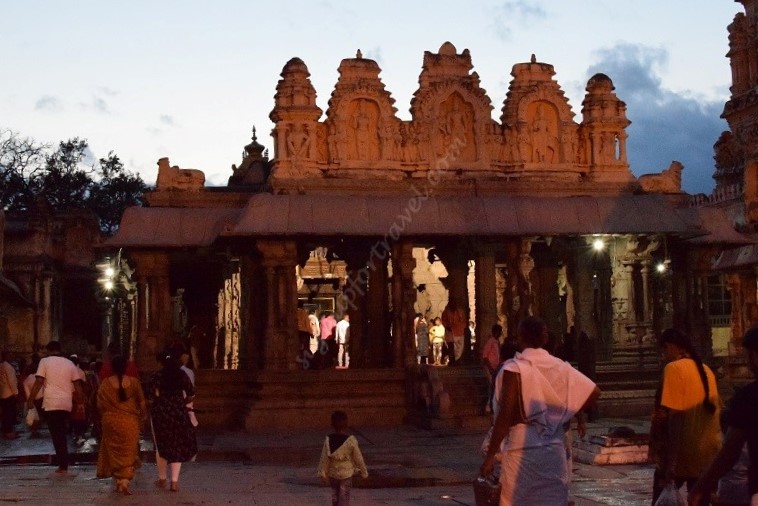
We had a nice darshan and the ambience was very good. It was worthy of being the most sacred temple in town and we were blessed enough to view it.
17. Closing Day 2
When we came out of Virupaksha temple, the time was 7.45 PM. We walked slowly and in a relaxed manner. Before heading back to our guest house, we strolled around the local market. It was just a small market with groceries, garment shops selling merchandise with Hampi inscribed and other small souvenir shops.
We went back to our guest house and again to the rooftop restaurant for dinner. The time was 9.30 PM. We had fried rice and noodles, we found it unremarkable. The lesson from this was not to veer away from the local specialties (like south Indian food) and experiment too much.
What a day it was! We started the day at Virupaksha temple and ended at the same place covering so many places and absorbing so much during the day. It was overwhelming at the end of the day to relive it, but then when a day ends it also will mark the beginning of a new day. With that in mind and looking forward to the next day, we ended day 2.
We hope you enjoyed reading our day 2 experience. Day 3 coming up….

